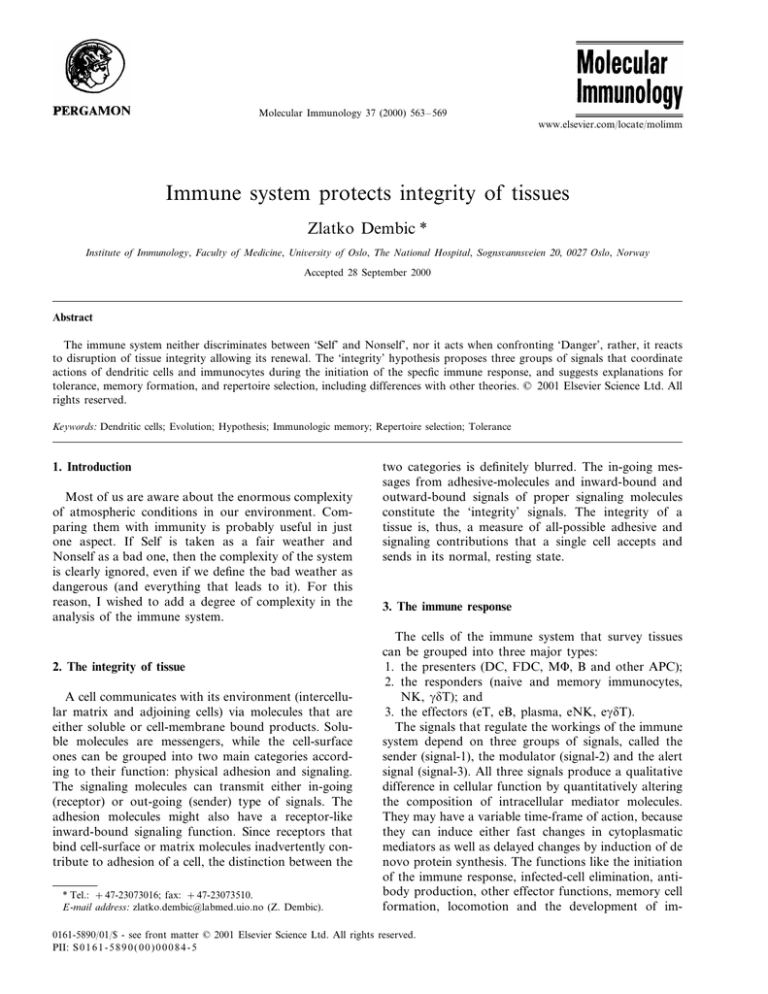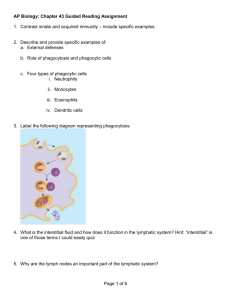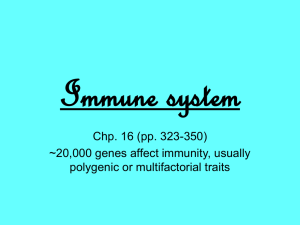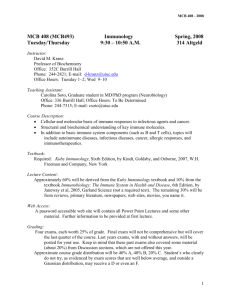
Molecular Immunology 37 (2000) 563 – 569
www.elsevier.com/locate/molimm
Immune system protects integrity of tissues
Zlatko Dembic *
Institute of Immunology, Faculty of Medicine, Uni6ersity of Oslo, The National Hospital, Sogns6anns6eien 20, 0027 Oslo, Norway
Accepted 28 September 2000
Abstract
The immune system neither discriminates between ‘Self’ and Nonself’, nor it acts when confronting ‘Danger’, rather, it reacts
to disruption of tissue integrity allowing its renewal. The ‘integrity’ hypothesis proposes three groups of signals that coordinate
actions of dendritic cells and immunocytes during the initiation of the specfic immune response, and suggests explanations for
tolerance, memory formation, and repertoire selection, including differences with other theories. © 2001 Elsevier Science Ltd. All
rights reserved.
Keywords: Dendritic cells; Evolution; Hypothesis; Immunologic memory; Repertoire selection; Tolerance
1. Introduction
Most of us are aware about the enormous complexity
of atmospheric conditions in our environment. Comparing them with immunity is probably useful in just
one aspect. If Self is taken as a fair weather and
Nonself as a bad one, then the complexity of the system
is clearly ignored, even if we define the bad weather as
dangerous (and everything that leads to it). For this
reason, I wished to add a degree of complexity in the
analysis of the immune system.
2. The integrity of tissue
A cell communicates with its environment (intercellular matrix and adjoining cells) via molecules that are
either soluble or cell-membrane bound products. Soluble molecules are messengers, while the cell-surface
ones can be grouped into two main categories according to their function: physical adhesion and signaling.
The signaling molecules can transmit either in-going
(receptor) or out-going (sender) type of signals. The
adhesion molecules might also have a receptor-like
inward-bound signaling function. Since receptors that
bind cell-surface or matrix molecules inadvertently contribute to adhesion of a cell, the distinction between the
* Tel.: +47-23073016; fax: +47-23073510.
E-mail address: zlatko.dembic@labmed.uio.no (Z. Dembic).
two categories is definitely blurred. The in-going messages from adhesive-molecules and inward-bound and
outward-bound signals of proper signaling molecules
constitute the ‘integrity’ signals. The integrity of a
tissue is, thus, a measure of all-possible adhesive and
signaling contributions that a single cell accepts and
sends in its normal, resting state.
3. The immune response
The cells of the immune system that survey tissues
can be grouped into three major types:
1. the presenters (DC, FDC, MF, B and other APC);
2. the responders (naive and memory immunocytes,
NK, gdT); and
3. the effectors (eT, eB, plasma, eNK, egdT).
The signals that regulate the workings of the immune
system depend on three groups of signals, called the
sender (signal-1), the modulator (signal-2) and the alert
signal (signal-3). All three signals produce a qualitative
difference in cellular function by quantitatively altering
the composition of intracellular mediator molecules.
They may have a variable time-frame of action, because
they can induce either fast changes in cytoplasmatic
mediators as well as delayed changes by induction of de
novo protein synthesis. The functions like the initiation
of the immune response, infected-cell elimination, antibody production, other effector functions, memory cell
formation, locomotion and the development of im-
0161-5890/01/$ - see front matter © 2001 Elsevier Science Ltd. All rights reserved.
PII: S 0 1 6 1 - 5 8 9 0 ( 0 0 ) 0 0 0 8 4 - 5
564
Z. Dembic / Molecular Immunology 37 (2000) 563–569
Z. Dembic / Molecular Immunology 37 (2000) 563–569
munocytes can be explained with the three-signal system. The restoration (regeneration) of a tissue is the
function of a tissue itself. The explanation of some
functions will be used as examples in describing the
signals.
1. The sender signal (signal-1) comprises a group of
various intracellular signals that are necessary and
sufficient for the activation of effector cells (Fig.
1A). However, signal-1 is not sufficient for the activation of responder cells (see signal-2), where it can
lead to programmed cell death, provided the cell is
in an alert state (see signal-3). Signal-1 can be a
group of inward-bound intracellular signals in immunocytes. It results in formation of intracellular,
extracellular and transmembrane molecules that are
capable of further in- or out-going signal transmission. Signal-1, for example, includes a communication between the dendritic cell and the responder T
cell via TCR, coreceptor and peptide/MHC
molecules; or antigen binding to BCR on responder
B cells.
2. Signal-2 consists of a group of intracellular signals
that modulate signal-1 (Fig. 1B). There are two
modes of action regarding signal-2: positive and
negative mode. In the positive mode, it can rescue
cells from apoptosis induced by signal-1 (negatively
regulating parts of signal-1 by, perhaps, downregulation of the mediators of apoptosis). Positive signal-2 can fix DNA accessibility and skew the levels
of second messengers induced by signal-1. In its
negative mode, it can potentiate signal-1, and even
lead to a faster cell death. For T cells, signal-2 can
be a group of inward-bound signals like, for example, costimulatory (B7/CD28 in a positive mode; or
B7/CD152 in a negative mode). For a myeloid DC,
a second signal would include ‘crosstalk’ between
DC and the responder T cell (in a positive mode)
enhancing DC antigen presentation during maturation of DC. For a B cell, it includes T-cell help in a
positive mode. However, a negative signal-2 for a B
cell would be a regulatory T cell.
3. Signal-3 controls the access to DNA in the nucleus,
which would include chromatin reorganization. Because of this, signal-3 can modulate signal-1 and
signal-2. Like the first two signals, signal-3 is different for different cell types. For immunocytes, it
comprises a complex network of signals initiated by
cytokines, hormones, chemokines, cell – cell, cell–
matrix, and other non-protein signals that can func-
565
tion as a ‘gate’ to other cellular functions (Fig. 1C).
For myeloid DC, signal-3 is one that results from
disruption of homeostatic signals. The latter I call
integrity signals of a tissue. The break up of inwardbound integrity signals, as in usual tissue disruptions due to infection, inflammation or physical
damage, alerts dendritic cells (i.e. they become ‘mature DC’) to initiate the immune response (Fig. 2).
For example, signal-3 can upregulate costimulatory
molecules CD80/86, which provide the signal-2 for
T cells. It can also modulate signal-1, perhaps, by
altering the conformation of peptides presented on
MHC molecules in DCs (Fig. 2). The variability of
integrity signals in tissues is large. For ease of
understanding, they can be compared with colors.
Thus, each signal-3 can have a different color. It
implies that signal-3 would facilitate differentiation
of specific immunocytes into different classes of
effector cells. For example, such ‘alerted’ T-cell
effectors can help or kill immediately upon the
receipt of signal-1.
The activation of specific immunocytes is defined as
capacitation of T or B cells to eliminate or suppress a
pathogen (or parasite, in a wider meaning). The activation of the immunocytes would include peripheral maturation from the naive or memory cell into a number of
effector states and classes, concomitant proliferation,
induction or change in the expression of various receptors, membrane-bound or cellular proteins and secretion of various products including cytokines and
chemokines. The initiation of the immune response is
defined as the activation of naive immunocytes. The
signal-3 could be mistaken for the first step of the
activation. It should be distinguished from it, as it may
be the first stage of the apoptosis, too.
4. The class of the immune response
Effector T cells can be of Th0, Th1, Th2, Th3, Tr,
Tc1 and Tc2 type (so far). These types of cells produce
qualitatively different immune responses, defining the
class of the response. The formation of different classes
of the response would be controlled by a distinct combination of three signals that a responder immunocyte
receives, especially regarding the ‘color’ of signal-3.
Immunocytes of different classes would differ in DNA
accessibility for factors that regulate class-specific genes
like those encoding various cytokines, chemokines and
Fig. 1. The signals controlling action of T cells. (A) Signal-1 comes from the binding of peptide/MHC complex on DCs by a TCR. (B) Signal-2
is a co-stimulatory signal that prevents apoptosis induced by signal-1 in a T cell. (C) Signal-3 controls access to DNA, and depending on its ‘color’,
different classes of T-cell responses are mounted.
Fig. 2. The signals controlling the initiation of the immune response. Myeloid dendritic cells (DC) scan integrative signals of all tissues. If broken
integrity signals are detected (at some threshold level), antigens in surroundings of DCs are picked up at an increased rate, processed and modified
before expression on MHC molecules for presentation (signal-1 for T cells). In parallel, co-stimulatory molecules (CD80/86) are upregulated
providing signal-2 for T cells.
566
Z. Dembic / Molecular Immunology 37 (2000) 563–569
their receptors. For example, the activation of T cells is
influenced by the color of signal-3 (the cytokines in
environment) that leads to Th1 or Th2 response. For B
cells, different colors would induce Ig class switching
and lead to Ig isotype differences.
5. Anergy and memory
The effectors are cells that by definition have signal-3
‘on’. In other words, they have a terminallyinduced differentiation state whereupon they can live
for a short period. If they get signal-1, the effectors will
die faster, but not before the execution of their function. However, if there is a shut-off of signal-3
during or after the initiation of the immune response,
the result will be a resting state, in which cells cannot
respond to signal-1 and signal-2. Let us consider two
examples:
1. The first is when the shut-off of signal-3 breaks
signals-(1+2). This can happen at earlier or later
stages of (1 +2) signaling. As a result, T cell becomes blocked or anergic, and will live until mechanically destroyed, or by age and other signals.
Later on, if the third signal is delivered again (because neither signal-1 nor signal-2 can yield
reactivation) the cell will die by apoptosis as incomplete signal-2 would not suffice for rescuing.
Rarely, the T or B cell can become reactivated, if
previous signaling (1+2) was near completion,
and the same color of the signal-3 was provided
again. Signal-3 can be switched off due to establishment of ‘normal’ integrative signals of a tissue, or
via other mediators in special circumstances (tumor).
2. The second consequence is when the signaling (1+
2) is complete and when immunocytes have become
effectors. To function as effectors, they would need
the signal-3 on, but because it is being shut-off, they
become memory cells. The shutting-off of signal-3
cannot completely reverse their DNA accessibility to
an earlier stage (naı̈ve T or virgin B cell). The
experience of past activation is represented as a
‘scar’ at the DNA level, because signal-3 has
already fixed the events during the first encounter
with an antigen. This makes the memory cells respond faster in the second encounter with signals1 + 2. Furthermore, if only signal-3 influences a
resting memory cell, the memory cell could just
divide, without becoming the effector. It follows
that memory cell maintenance would not need signal-1. For example, MHC would not be needed for
the maintenance of T-cell memory, but it would be
required for the establishment of memory cells, and
the activation of a memory cell to become an effector again.
6. The evolutionary aspects
I suggest that the mechanism that generates V(D)J
rearrangements in TCR and Ig molecules, tries to neutralize all germ-line encoded diversity. The result of the
scrambling of the germ-line diversity produces completely new binding properties and, thus, specificity.
The recognition function seems to be re-generated for
every new member of a species.
In a biological system, the conservation of molecular
structure during evolution implies an important function. For example, similarity of cytochrome c molecules
among many species points to its non-adaptable and
non-replaceable function in the generation of cellular
energy. Where do we find such conserved elements in
the immune system? The conservation of constant parts
of Igs, TCRs and MHC molecules, intracellular mediators, and other cell-membrane molecules involved in
immunological signalling, indicates a selective pressure
for all three signalling functions except the recognition
function (of signal-1) within the immune system. However, considering the V regions of Igs and TCRs, we see
a paradox. The germ-line encoded Vs are also conserved. In other words, all but the last antigen-(pMHC)binding region, encoded by the V(D)J portions in
mature immunocytes, are preserved. Thus, we find that
immune repertoires may differ in:
1. the usage of clonally distributed germ-line V region
alleles (including Ds and Js);
2. somatic V(D)J rearrangements during development
of T and B cells; and
3. somatic selection of individually distributed repertoires (positive and negative selection).
This 6ariability in individual repertoires may, at a
first glance, mean an indifference in evolutionary terms
for the binding specificities of the recognition structures
in the signal-1. However, we see that the framework
and the first two/three antigen-(pMHC-)binding sites of
the V regions are evolutionarily conserved. I suggest
that this is so because of a need for internal communication, in particular, between the inducing/responder
and the effector/target branch of the immune response.
The pressure acting on maintenance of the ‘interactivity’ within the immune system would predict the finding
of ‘mutually interactive’ sets of TCR/MHC and Id/antiId (or Ig/?) combinations within the ‘non-selected’
repertoires of related species, declining with evolutionary distance. Next, this interactivity renders any defense
system vulnerable to pathogens that can change its
dominant antigenic profile and produce an imitation of
Self. To solve this problem, organisms evolved that
could scramble the original interactivity, and re-assemble it with each new generation. Thus, in the primordial
immune system, the uniform MHC-binding receptor
may have become scrambled (rearranged), and upon
re-assembly, each new variant of V, that helped in
Z. Dembic / Molecular Immunology 37 (2000) 563–569
fighting off intruders, would have been selected to stay
in the germ-line-but only if it was also interactive. It
follows that the diversity of recognition is evolutionarily selected by two opposing selective forces:
1. a pressure to bind Self for communication (preserving TCR/MHC and Ig/? or Ig-Id/Ig-anti-Id combinations); and
2. a pressure not to harm Self (tolerance) by conserving molecules involved in scrambling the evolutionarily selected (parts of) molecules selected by the
first force, namely, the V regions of Igs and TCRs
(gene rearrangement) or MHC alleles (gene
conversion).
The second force can effectively destroy all the binding that is conserved by the first force in just a single 12
generation: V paratopes and alpha helices of MHC
molecules. This force (‘not to harm S’) may be confused
with, and assigned as the selection for binding NS! On
the contrary, in order to re-establish effective communication within the immune system, a repertoire of recognition has to be tailor-made for every individual during
ontogeny. This correlates to positive selection of developing T and B cells.
In conclusion, the specificity of the immune response
or the variability of structures involved in signal-1 have
an evolutionary advantage over uniform defense mechanisms. Specific recognition of antigens by B and T
cells is a part of the evolutionary process that aims to
protect the integrity of tissues through cellular intercommunication. For immunocytes, it was advantageous
to more precisely link afferent and efferent arms of a
defense system. The ‘integrity’ hypothesis proposes that
the survival of the ‘integrity of a tissue’ within an organ
depends on the immune system. It reacts to a disruption of tissues and allows renewal. The repertoire of
immunocytes represents a data base of past disturbances and intelligence network preventing tissue
dilapidation.
7. The predictions
All three types of cells involved in the immune response can be controlled with the sender, modulator
and alertness signals. The challenge would be to identify molecules that fit these descriptions in DCs, B, T,
and NK cells. Alerted DCs might provide a different
‘color’ of signal-3 to responding immunocytes. Some
might ask, why do we need theories, and groups of
chaotic signals, when we will relatively soon know all
intracellular mediators in the coming post-genomic era.
Well, it is just another human characteristic to make
life more interesting, colorful and challenging. For example, which mediators are more important than the
others? In other words, which ones shall we pursue first
(and try to use inhibitors in clinics)? Good theories give
567
major advantages. I’d like to call such theories —
catalysts of cultural progress.
Signal-3 represents a complex group of signals. Some
of those can modify signal-1 at various points. Signal-3
might upregulate enzymes that affect post-translational
modification or processing of (Self and Non-self) antigens. The presentation of an antigen would not be
modified, because this change might only slightly alter
the conformation of the peptide. Therefore, a peptide
might still bind the MHC molecule, but it would
provide a different T-cell epitope. For example, this
could be achieved by deamidation of lysines in peptides,
which introduces a charge difference, similar to deamidated gliadin peptides that can induce coeliac disease
(Molberg et al., 1998). It follows that constitutively
active individual components of signal-3 could form a
basis for the immune-cell attack.
The complexity of signal-3 is defined as all possible
combinations of mediators that will modify signal-2. In
principle, signal-3 will upregulate (positively) signal-2 to
provide co-stimulation for B or T cells. Thus, co-stimulation for a B cell would be not only T-cell help, but
also cross-linking of various B-cell membrane components that would yield similar intracellular transmissions, perhaps similar to suggested T-independent B-cell
activation upon cross-linking of LPS/Toll receptors
(Moller, 1999).
Signal-3 can be possibly switched off due to establishment of ‘normal’ integrative signals of a tissue, or
via other putative mediators (mimicry of integrity?). It
is possible that there is a refractory period until T or B
cells can be alerted again. The refractory state could be
different for various cells and states.
The classes of immune responses are generated by the
differences in the ‘color’ of signal-3 delivered to T cells.
Memory cells can be generated by shutting-off of the
signal-3 in effector cells.
Tolerance can be achieved by the delivery of signal-1
(clonal deletion), or signal-1 in combination with the
negative-mode of signal-2 to immunocytes in alerted
state. The classes of immune response that generate
Th1, Th2 or Tc1 and Tc2 are generated by different
‘colors’ of signal 3 delivered to T cells upon activation
by signal-1 and positive signal-2. However, the same
colors can produce different classes, if signal-2 were
negative (CD154) resulting in, for example, regulatory
Tr1 and Th3 cells instead of Th1 and Th2. Such cells
could compete or inhibit other classes of the immune
response.
The B-cell receptors (BCRs) might have a corresponding positive-selecting molecule, analogous to the
TCR-selecting MHC molecules, which may have been
lost during evolution, perhaps due to anti-Id stepping
into its place.
Lastly, the immune system could be manipulated to
adopt Nonself as Self (and vice versa) by appropriate
568
Z. Dembic / Molecular Immunology 37 (2000) 563–569
modulation of signal-2 and signal-3. This is a testable
challenge, and if accepted, it would widen the field of
research, in order to find successful treatments for
preventing graft rejections and auto-immune diseases.
8. The differences with other theories
The Self–Nonself discrimination principle describes in
simple terms how selective rather than instructive mechanisms might operate within the immune system (Lederberg, 1959). Bretscher and Cohn (1970) proposed a
model of lymphocyte activation that involves a two-signal activation mechanism, which revolutionized our
concept about the initiation of the immune response.
Then, Langman and Cohn (1996), in the ‘Associative
Antigen Recognition’ model, developed further the S-NS
discrimination concept involving the NS-recognition-signal-dependent activation of specific immunocytes. In
contrast, Coutinho and Stewart (1991) and Bandeira
(1996) proposed a dominant suppression concept based
on Jernean-idiotype network and S/NS discrimination
principle (‘Suppression network’). Next, Janeway (1989)
in ‘Stranger’ and Fuchs and Matzinger in ‘Danger’
(Matzinger, 1994; Fuchs and Matzinger, 1996) models,
assigned an alarming signal for the initiation of the
immune response upon ‘intrusion of the pathogen’
(stranger; infectious-Self) or when ‘cellular (or tissue)
death (necrosis), distress and disruption’ (danger) are
sensed. There are other theories like ‘Morphostasis’,
‘Cytokine-burst’ or ‘Antigen localization’ (Ignorance),
by Cunliffe (1995), Weigle (1995) and Zinkernagel
(1996), respectively, which stressed the importance of the
context of an antigenic challenge. The ‘Integrity’ model
formulates a novel set of rules that might operate within
the immune system, and was first mentioned in 1996
(Dembic, 1996) and discussed on the internet in 1997
(Bandeira et al., 1997).
Here are the differences among the various theories
about the workings of the immune system from the
point-of-view of ‘Integrity’.
The Self–Nonself discrimination principle means that
signal-1 and signal-2 (without signal-3) suffice for the
initiation of the immune response (Langman and Cohn,
1996), whereas, all three signals are required in ‘Danger’,
‘Stranger’ and ‘Integrity’ theories.
The ‘Danger’ (Matzinger, 1994; Fuchs and Matzinger,
1996) and ‘Stranger’ (Janeway, 1989) theories differ from
‘Integrity’ by proposing that signal-3-like events are
positive inward-bound signals for DCs in the initiation
of the immune response. ‘Danger’ implies that the
recognition of some cellular subparts is sufficient. However, ‘Stranger’ claims that a recognition of some kind
of general property(ies) of intruding microorganisms
(infectious-self) is the initiator. ‘Integrity’ proposes that
a break-up of constant networking signals of cells within
a tissue would be recognized as signal-3 by DCs (Fig. 2).
Furthermore, there is no mentioning of signal-3 (or
access to DNA) for immunocytes playing any role in the
initiation of the immune response by ‘Danger’ and
‘Stranger’. Similarly, in explaining development, memory
and class of the response, ‘Danger’ and ‘Stranger’ theories do not involve signal-3, while ‘Integrity’ does.
The ‘Ignorance’ (Zinkernagel, 1996) hypothesis proposes that immunocytes are localized in lymph nodes
until a dendritic cell arrives and provides two signals for
the initiation of the immune response. As effectors, they
may move to the site of an infection. Outside these
‘working hours’, like, for example, when naı̈ve or memory immunocytes are by chance in tissues, they cannot
receive either signal-1 or signal-2, because they are
ignorant. I have two major criticisms for the ‘Ignorance’
theory. First of all, immunocytes cannot be ignorant,
because they learned about these signals during ontogeny
(positive selection). Secondly, there is a problem with
who holds the master switch when ‘ignorant’ cells should
become ‘erudite’. Being simply in the lymph nodes does
not sufficiently explain this decision. On the other hand,
‘Integrity’ and ‘Danger’ suggests that passing immunosurveilant lymphocytes in tissues can respond to both
signal-1 and signal-2. The reason why they do not
become activated is that, in well-integrated tissues, no
signal-2 is available. Thus they can only receive signal-1,
and be deleted.
The ‘Suppressive network’ (Coutinho and Stewart,
1991; Bandeira, 1996) theory would imply a break of the
suppressing interaction of an Ig-Id with its anti-Id as a
shift in regulatory forces that would kick start the
response. For T cells, it suggests that a loss of a constant,
mutually-suppressive interaction between ‘Id’-TCR and
anti-Id (pMHC) on APC would provoke T-cell activation. In other words, the initiation of an immune
response to an antigen would be the result of a break in
the constant signaling (signal-1+ signal-2) interaction
within the immune system. In a way, it would be a shift
of the reactivity (to NS) rather than the initiation. The
‘Morphostasis’ theory (Cunliffe, 1995, 1997, 1999) has a
similarity with Integrity, in claiming that disorganization
in tissues provokes the immune response. The ‘Cytokineburst’ hypothesis (Weigle, 1995) describes a powerful
controlling network of soluble mediators. The differences
in cytokine quantities could alter the states of immunocytes and cause them to start the response. The ‘Integrity’
theory sees them as not so powerful, but just as the
soluble parts of ‘integrity’ signals providing colorful
immune responses.
References
Bandeira, A., 1996. The evolutionary origins of immunoglobulins and
T cell receptors. Res. Immunol. 147, 193 – 268.
Z. Dembic / Molecular Immunology 37 (2000) 563–569
Bandeira, A., Dembic, Z., Fuchs, E.J., Green, D., Langman, R.E.,
Weigle, W.O., 1997. Models of immunologic tolerance: A debate.
In HMS Beagle: A BioMedNet Publication (http://hmsbeagle.com/1997/11/cutedge/day1.htm), Issue 11, June 27.
Bretscher, P., Cohn, M., 1970. A theory of self–nonself discrimination: paralysis and induction involve the recognition of one and
two determinants on an antigen, respectively. Science 169, 1042 –
1049.
Coutinho, A., Stewart, J., 1991. A hundred years of immunology.
Paradigms, paradoxes and perspectives. In: Cazenave, J., Talwar,
G.P. (Eds.), Immunology: Pasteur’s Heritage. Wiley, New York,
pp. 175 – 199.
Cunliffe, J., 1995. Morphostasis and immunity [published erratum
appears in Med. Hypotheses 44(5) (1995) 428]. Med. Hypotheses
44, 89 – 96.
Cunliffe, J., 1997. Morphostasis: an evolving perspective. Med. Hypotheses 49, 449 – 459.
Cunliffe, J., 1999. From terra firma to terra plana — danger is
shaking the foundations: deconstructing the ‘immune system’.
Med. Hypotheses 52, 213–219.
Dembic, Z., 1996. Do we need integrity? Scand. J. Immunol. 44,
549 – 550.
Fuchs, E.J., Matzinger, P., 1996. Is cancer dangerous to the immune
system? Semin. Immunol. 8, 271–280.
Janeway, C.A., 1989. Approaching the asymptote? Evolution and
.
569
revolution in immunology. Cold Spring Harb. Symp. Quant. Biol.
54, 1 – 13.
Langman, R.E., Cohn, M., 1996. A short history of time and space in
immune discrimination [see comments]. Scand. J. Immunol. 44,
544 – 548.
Lederberg, J., 1959. Genes and antibodies: Do antigens bear instructions for antibody specificity or do they select cell lines that arise
by mutation? Science 129, 1649 – 1653.
Matzinger, P., 1994. Tolerance, danger, and the extended family.
Annu. Rev. Immunol. 12, 991 – 1045.
Molberg, O., McAdam, S.N., Korner, R., Quarsten, H., Kristiansen,
C., Madsen, L., Fugger, L., Scott, H., Noren, O., Roepstorff, P.,
Lundin, K.E., Sjostrom, H., Sollid, L.M., 1998. Tissue transglutaminase selectively modifies gliadin peptides that are recognized
by gut-derived T cells in celiac disease [see comments] [published
erratum appears in Nat. Med. 4(8) (1998) 974]. Nat. Med. 4,
713 – 717.
Moller, G., 1999. Receptors for innate pathogen defence in insects are
normal activation receptors for specific immune responses in
mammals. Scand. J. Immunol. 50, 341 – 347.
Weigle, W.O., 1995. Immunologic tolerance: development and disruption [comment]. Hosp. Pract. (Off. Ed.) 30, 81 – 84, 89 – 92.
Zinkernagel, R.M., 1996. Immunology taught by viruses [see comments]. Science 271, 173 – 178.






